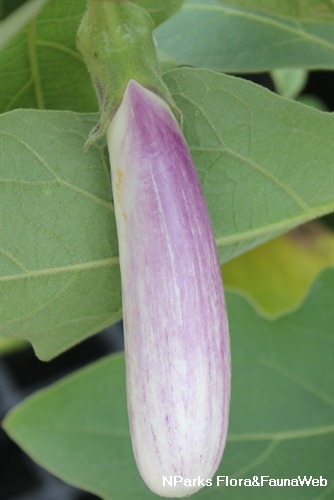
Name
Classifications and Characteristics
| Plant Division | Angiosperms (Flowering Seed Plants) (Dicotyledon) |
|---|---|
| Plant Growth Form | Herbaceous Plant |
| Lifespan (in Singapore) | Annual |
| Mode of Nutrition | Autotrophic |
| Maximum Height | 1.5 m |
Biogeography
| Native Distribution | Indo-Burmese region |
|---|---|
| Native Habitat | Terrestrial |
| Preferred Climate Zone | Tropical, Sub-Tropical / Monsoonal |
| Local Conservation Status | Non-native (Horticultural / Cultivated Only) |
Description and Ethnobotany
| Growth Form | Erect, branching herb up to 1.5 m tall. It is a perennial plant which is commonly grown as an annual. |
|---|---|
| Foliage | Hairy leaves are ovate (egg-shaped) to ovate-oblong (elongated egg shape). Leaf margin is sinuately lobed, winding in and out like a repeating s-shaped pattern. |
| Stems | The herbaceous stem becomes slightly woody over time. |
| Flowers | Purple, funnel-shaped flowers have 5-6 pointed lobes which form a star-like shape. They are either bisexual or male. |
| Fruit | The fruit, known as a berry, grows up to 40 cm long and 20 cm wide. It may be egg-shaped (with the pointed end at the base or apex), elongated or round to approximately round. The fruit has a smooth, glossy skin. |
| Cultivation | It takes about 105-133 days from sowing to first harvest. |
| Ethnobotanical Uses | Edible Plant Parts : Edible Fruits, Edible Seeds Food (Fruit or Vegetable): Fruits are typically consumed as a cooked vegetable. However, there is a light green, elongated version which is eaten raw in Indonesia. |
Landscaping Features
| Thematic Landscaping | Economic Garden |
|---|---|
| Plant & Rootzone Preference or Tolerance Remarks | Grows best in sandy loam. |
Plant Care and Propagation
| Light Preference | Full Sun |
|---|---|
| Water Preference | Moderate Water |
| Plant Growth Rate | Moderate |
| Rootzone Tolerance | Well-Drained Soils |
| Potential Problems | Brinjal is prone to being attacked by aphids, spider mites, whiteflies and root knot nematodes. To learn more about how to manage these pests and care for Brinjal, please click on this NParks' link: NParks' Gardening Resources. |
| Pest(s) | Sucking Insects, Nematodes |
| Propagation Method | Seed |
| Seed / Spore Germination Duration | 14 days |
Foliar
| Foliage Retention | Evergreen |
|---|---|
| Mature Foliage Colour(s) | Green |
| Mature Foliage Texture(s) | Hairy / Hirsute |
| Foliar Type | Simple / Unifoliate |
| Foliar Arrangement Along Stem | Alternate |
| Foliar Attachment to Stem | Petiolate |
| Foliar Shape(s) | Non-Palm Foliage (Ovate, Oblong) |
| Foliar Venation | Pinnate / Net |
| Foliar Margin | Sinuate |
| Foliar Apex - Tip | Acute, Obtuse |
| Foliar Base | Rounded / Obtuse, Cordate |
| Typical Foliar Area | Macrophyll ( 182.25cm2 - 1640.25 cm2 ) |
| Leaf Area Index (LAI) for Green Plot Ratio | 4.5 (Shrub & Groundcover - Dicot) |
| Typical Foliar Size | 3 cm to 25 cm |
Floral (Angiosperm)
| Flower & Plant Sexuality | Unisexual & Bisexual Flowers(Sub-dioecious) |
| Flower Colour(s) | Purple |
|---|---|
| Flower Texture(s) | Wrinkled |
| Flower Grouping | Solitary, Cluster / Inflorescence |
| Flower Location | Axillary |
| Flower Symmetry | Radial |
| Individual Flower Shape | Stellate / Star-shaped |
| Inflorescence Type | Cyme |
| Flowering Habit | Polycarpic |
| Flower Size | 4 cm |
Fruit, Seed and Spore
| Mature Fruit Colour(s) | Purple, White, Yellow / Golden, Black, Green |
|---|---|
| Mature Fruit Texture(s) | Smooth, Glossy / Shiny |
| Fruit Classification | Simple Fruit |
| Fruit Type | |
| Mature Seed Colour(s) | Brown |
| Seed Quantity Per Fruit | Numerous (>20) |
Image Repository
Others
| Master ID | 1166 |
|---|---|
| Species ID | 2459 |
| Flora Disclaimer | The information in this website has been compiled from reliable sources, such as reference works on medicinal plants. It is not a substitute for medical advice or treatment and NParks does not purport to provide any medical advice. Readers should always consult his/her physician before using or consuming a plant for medicinal purposes. |









